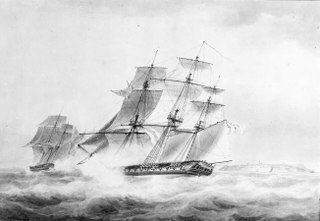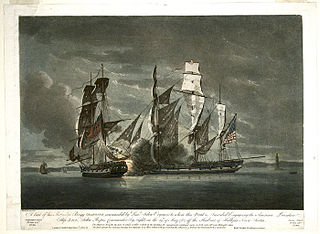Related Research Articles

HMS Indefatigable was one of the Ardent-class 64-gun third-rate ships-of-the-line designed by Sir Thomas Slade in 1761 for the Royal Navy. She was built as a ship-of-the-line, but most of her active service took place after her conversion to a 44-gun razee frigate. She had a long career under several distinguished commanders, serving throughout the French Revolutionary Wars and the Napoleonic Wars. She took some 27 prizes, alone or in company, and the Admiralty authorised the issue of four clasps to the Naval General Service Medal in 1847 to any surviving members of her crews from the respective actions. She was broken up in 1816.

Révolutionnaire, was a 40-gun Seine-class frigate of the French Navy, launched in May 1794. The British captured her in October 1794 and she went on to serve with the Royal Navy until she was broken up in 1822. During this service Revolutionnaire took part in numerous actions, including three for which the Admiralty would in 1847 award clasps to the Naval General Service Medal, and captured several privateers and merchant vessels.

HMS Phoenix was a 36-gun Perseverance-class fifth-rate frigate of the Royal Navy. The shipbuilder George Parsons built her at Bursledon and launched her on 15 July 1783. She served in the French Revolutionary and Napoleonic Wars and was instrumental in the events leading up to the battle of Trafalgar. Phoenix was involved in several single-ship actions, the most notable occurring on 10 August 1805 when she captured the French frigate Didon, which was more heavily armed than her. She was wrecked, without loss of life, off Smyrna in 1816.

Sibylle was a 38-gun Hébé-class frigate of the French Navy. She was launched in 1791 at the dockyards in Toulon and placed in service in 1792. After the 50-gun fourth rate HMS Romney captured her in 1794, the British took her into service as HMS Sybille. She served in the Royal Navy until disposed of in 1833. While in British service, Sybille participated in three notable single-ship actions, in each case capturing a French vessel. On anti-slavery duties off West Africa from July 1827 to June 1830, Sybille captured many slavers and freed some 3,500 slaves. She was finally sold in 1833 in Portsmouth.

HMS Mercury was a 28-gun Enterprise-class sixth-rate frigate of the Royal Navy. She was built during the American War of Independence and serving during the later years of that conflict. She continued to serve during the years of peace and had an active career during the French Revolutionary Wars and most of the Napoleonic Wars, until being broken up in 1814.

HMS Sappho was a Cruizer class brig-sloop built by Jabez Bailey at Ipswich and launched in 1806. She defeated the Danish brig Admiral Yawl in a single-ship action during the Gunboat War, and then had a notably successful two months of prize-taking in the first year of the War of 1812. She was wrecked in 1825 off the Canadian coast and then broken up in 1830.
HMS Drake was a 14-gun brig-sloop of the Royal Navy. She was bought from a commercial builder during the early years of the American War of Independence, and went on to support operations in the English Channel and the Caribbean. At one stage she assisted an attack on a French-held island, an expedition commanded by a young Horatio Nelson. Laid up for a time after the end of the American War of Independence, she returned to service shortly before the outbreak of the French Revolutionary Wars. Drake spent most of her time in Caribbean waters, until being declared unfit for service in 1800 and deleted from the navy lists.

Tyrannicide was a 14-gun brigantine-rigged sloop of the Massachusetts State Navy. The ship was built for the American Revolutionary War and participated in commerce raiding until destroyed in the Penobscot expedition.

HMS Surprise was a 28-gun Enterprise-class sixth-rate frigate of the Royal Navy, which served throughout the American Revolutionary War and was broken up in 1783.
HMS Vestal was a 28-gun Enterprise-class sixth-rate frigate of the Royal Navy.

HMS Aurora was a 28-gun Enterprise-class sixth-rate frigate of the Royal Navy, that saw service during the American and French Revolutionary wars, and the Napoleonic Wars. Designed to carry a complement of 200 men, she was armed with a main battery of twenty-four 9-pound guns.

HMS Southampton was the name ship of the 32-gun Southampton-class fifth-rate frigates of the Royal Navy. She was launched in 1757 and served for more than half a century until wrecked in 1812.

HMS Vulture was a 14 to 16-gun ship sloop of the Swan class, launched for the Royal Navy on 18 March 1776. She served during both the American Revolutionary War and the French Revolutionary War, before the Navy sold her in 1802. Vulture is perhaps best known for being the warship to which Benedict Arnold fled on the Hudson River in 1780 after unsuccessfully trying to surrender the Continental Army fort at West Point, New York to the British.
Éole was an 18-gun corvette of the French Navy, launched, captured, and later commissioned in the Royal Navy in 1799 as HMS Nimrod after her capture by HMS Solebay. She was then "the finest and most handsome ship-sloop in the British navy". She was sold in 1811. Nimrod made three whaling voyages between 1811 and 1819. On her first she captured several American whalers. Nimrod was last listed in 1820.
The French brig Duc de Chartres was built between 1779 and 1780 at Le Havre as a 24-gun privateer. As a privateer she captured one British warship before in 1781 the Royal Navy captured her. The Royal Navy took her into service as HMS Duc de Chartres. She then captured several American privateers and armed merchant vessels, and one French naval corvette in a noteworthy single-ship action. The Navy sold Duc de Chartres in 1784.

Rifleman was a Cruizer-class brig-sloop launched in 1809 for the Royal Navy. She served in the North Sea, on the Halifax and Jamaica stations, and in the Mediterranean Sea. During her service she recaptured a Royal Navy vessel in Danish service, and two privateers. The Navy sold her in 1836 and she proceed to sail as a merchantman and whaler between 1837 and 1856.
HM galley Comet was the South Carolina Navy's brigantine Comet, which the government of South Carolina purchased in 1775. The British Royal Navy captured her in 1777. She grounded and was destroyed in 1780.

Captain David Ropes was a notable American privateer from Salem, Massachusetts who fought in numerous naval battles during the American Revolutionary War. He was taken prisoner twice during the war and then killed in the Battle off Halifax (1782).
HMS Barbadoes was a 16-gun vessel, the American Herald, captured in 1813. The Royal Navy took her into service as HMS Barbadoes She captured a number of merchantmen and privateers before she was paid-off in May 1816. In 1814–1815 she also captured three Spanish and French slave ships carrying over 1100 enslaved people. Barbadoes became a powder ship in Jamaica that was later wrecked with her remains being sold.
HMS Martin was launched in Bermuda in 1809. Commander John Evans then commissioned her at Halifax Nova Scotia. During the War of 1812, Martin spent much of her time on the Halifax station. She captured or shared in the capture of numerous small merchant vessels. She also captured a small United States privateer, and was involved in an action with United States gunboats. After the war she conducted patrols against smugglers. She was on one of those patrols when she was wrecked in 1817.
References
- Lehman, John (2002). On Seas of Glory: Heroic Men, Great Ships, and Epic Battles of the American Navy. Simon and Schuster. ISBN 9780684871776.
- Simpson, Edward (1886). "United States Naval Artillery". Harper's New Monthly Magazine. Vol. 73, no. 437. pp. 779–794.
- Vice-Admiralty Court, Halifax (1911). American vessels captured by the British during the revolution and war of 1812. Salem, Mass.: Essex Institute. hdl:2027/mdp.39015070578847.
- Yarsinke, Amy Waters (2007). The Elizabeth River. The History Press. ISBN 9781596292079.